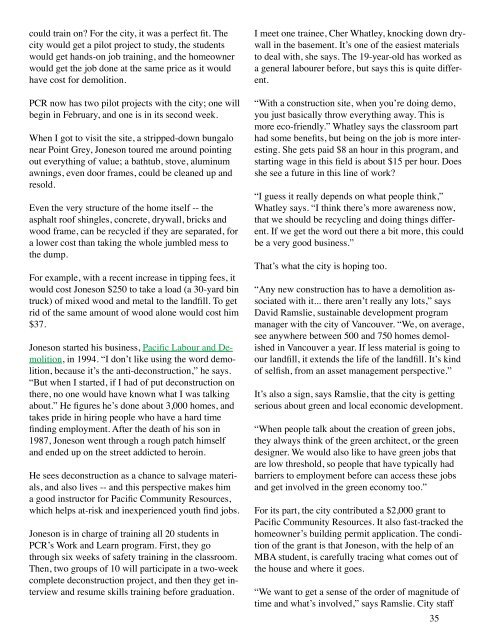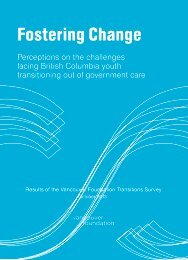from the ground up - The Tyee
from the ground up - The Tyee
from the ground up - The Tyee
You also want an ePaper? Increase the reach of your titles
YUMPU automatically turns print PDFs into web optimized ePapers that Google loves.
could train on? For <strong>the</strong> city, it was a perfect fit. <strong>The</strong>city would get a pilot project to study, <strong>the</strong> studentswould get hands-on job training, and <strong>the</strong> homeownerwould get <strong>the</strong> job done at <strong>the</strong> same price as it wouldhave cost for demolition.PCR now has two pilot projects with <strong>the</strong> city; one willbegin in February, and one is in its second week.When I got to visit <strong>the</strong> site, a stripped-down bungalonear Point Grey, Joneson toured me around pointingout everything of value; a bathtub, stove, aluminumawnings, even door frames, could be cleaned <strong>up</strong> andresold.Even <strong>the</strong> very structure of <strong>the</strong> home itself -- <strong>the</strong>asphalt roof shingles, concrete, drywall, bricks andwood frame, can be recycled if <strong>the</strong>y are separated, fora lower cost than taking <strong>the</strong> whole jumbled mess to<strong>the</strong> dump.For example, with a recent increase in tipping fees, itwould cost Joneson $250 to take a load (a 30-yard bintruck) of mixed wood and metal to <strong>the</strong> landfill. To getrid of <strong>the</strong> same amount of wood alone would cost him$37.Joneson started his business, Pacific Labour and Demolition,in 1994. “I don’t like using <strong>the</strong> word demolition,because it’s <strong>the</strong> anti-deconstruction,” he says.“But when I started, if I had of put deconstruction on<strong>the</strong>re, no one would have known what I was talkingabout.” He figures he’s done about 3,000 homes, andtakes pride in hiring people who have a hard timefinding employment. After <strong>the</strong> death of his son in1987, Joneson went through a rough patch himselfand ended <strong>up</strong> on <strong>the</strong> street addicted to heroin.He sees deconstruction as a chance to salvage materials,and also lives -- and this perspective makes hima good instructor for Pacific Community Resources,which helps at-risk and inexperienced youth find jobs.Joneson is in charge of training all 20 students inPCR’s Work and Learn program. First, <strong>the</strong>y gothrough six weeks of safety training in <strong>the</strong> classroom.<strong>The</strong>n, two gro<strong>up</strong>s of 10 will participate in a two-weekcomplete deconstruction project, and <strong>the</strong>n <strong>the</strong>y get interviewand resume skills training before graduation.I meet one trainee, Cher Whatley, knocking down drywallin <strong>the</strong> basement. It’s one of <strong>the</strong> easiest materialsto deal with, she says. <strong>The</strong> 19-year-old has worked asa general labourer before, but says this is quite different.“With a construction site, when you’re doing demo,you just basically throw everything away. This ismore eco-friendly.” Whatley says <strong>the</strong> classroom parthad some benefits, but being on <strong>the</strong> job is more interesting.She gets paid $8 an hour in this program, andstarting wage in this field is about $15 per hour. Doesshe see a future in this line of work?“I guess it really depends on what people think,”Whatley says. “I think <strong>the</strong>re’s more awareness now,that we should be recycling and doing things different.If we get <strong>the</strong> word out <strong>the</strong>re a bit more, this couldbe a very good business.”That’s what <strong>the</strong> city is hoping too.“Any new construction has to have a demolition associatedwith it... <strong>the</strong>re aren’t really any lots,” saysDavid Ramslie, sustainable development programmanager with <strong>the</strong> city of Vancouver. “We, on average,see anywhere between 500 and 750 homes demolishedin Vancouver a year. If less material is going toour landfill, it extends <strong>the</strong> life of <strong>the</strong> landfill. It’s kindof selfish, <strong>from</strong> an asset management perspective.”It’s also a sign, says Ramslie, that <strong>the</strong> city is gettingserious about green and local economic development.“When people talk about <strong>the</strong> creation of green jobs,<strong>the</strong>y always think of <strong>the</strong> green architect, or <strong>the</strong> greendesigner. We would also like to have green jobs thatare low threshold, so people that have typically hadbarriers to employment before can access <strong>the</strong>se jobsand get involved in <strong>the</strong> green economy too.”For its part, <strong>the</strong> city contributed a $2,000 grant toPacific Community Resources. It also fast-tracked <strong>the</strong>homeowner’s building permit application. <strong>The</strong> conditionof <strong>the</strong> grant is that Joneson, with <strong>the</strong> help of anMBA student, is carefully tracing what comes out of<strong>the</strong> house and where it goes.“We want to get a sense of <strong>the</strong> order of magnitude oftime and what’s involved,” says Ramslie. City staff35








